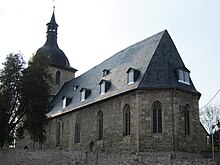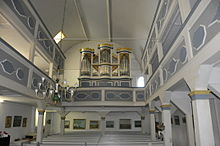St. Johannis (Magdala)
The Protestant town church St. Johannis is in the town of Magdala in the Weimarer Land district in Thuringia . It belongs to the parish of Magdala / Bucharest in the church district Jena the Evangelical Church in Central Germany .
history
The new foundation was located near the old settlement of Magdala. Today there is the desert floor member Old Town . It is still noticeable that the distance between the church and the town hall is inexplicable. According to the chronicler, the church must have had its origins in the last stages of the initial settlement. Which are the oldest parts of the church remains rather a mystery. The following information is available:
- In the south side of the church there are round portals that suggest a Romanesque predecessor building. The western of the south portals was built in 1546. Many joints in the foundation wall with slate in the binder indicate one of the oldest bonding techniques.
- Judging by its foundation walls, the mighty west tower was probably a castle-like watchtower to protect and control the place, the paths and the surrounding area. The protective name St. Johannes Baptista points to an original parish with baptism and burial rights. Under the sacristy there is a crypt , also called a charnel house or charnel house .
- On the north side of the church there is the walled-in relief of a face that resembles that of the patron saint John the Baptist .
Church building
The core of the large hall church with west tower is from the 14th century. The devastating destruction in the Saxon fratricidal war puzzles the age of the church.
Choir
From 1513 to 1516 was carried out according to a inscription on the outer south-east corner of the building of three-sided chancel at a ruinous older part, must have been at the same time together with either or later. The inscription says: In the year of the Lord 1516 this choir was built in honor of John the Baptist. It is the earliest certain evidence of Church history. All old documents and monks ' writings were burned with the parish in the Thirty Years' War in 1630.
tower
1610–1613 today's tower got its tail cap . The tower flag still bears the year 1610 today. The tower houses three bells, two of which are cast steel bells that replace those sacrificed in the First World War . The third bell is the oldest: it was cast from bronze in Erfurt in 1567.
Church hall, chancel
The church hall with its wooden barrel vault and two-story galleries , impressed by the baroque pulpit altar with side figures, was completed in 1739–1741. At the top left is the figure of the patron saint of the Church, John the Baptist; on the right side you can see the horned Moses with the tablets of the law in the left. The church chronicle reports that 62 trees were used for the pulpit, pulpit stairs and confessional . The pulpit was painted in 1763. This painting was largely observed during the last church renovation in 1983. B. the "consecration crosses" were made visible again.
On the wall of the chancel there are two coats of arms with plaques commemorating the former manor owner Paul Klein von Gleen, who died in 1686 and was buried with his wife in the church. On the right wall of the choir there is an epitaph donated by a mayor of the town around 1610 in memory of his deceased wife. To the left of the altar, an oil painting from the Cranach School shows the former owner of the noble court and church patron Valten von Harras .
In the northern choir wall there is a pointed arched door that leads to the oldest part of the church, a room with a groin vault in a high Gothic architectural style, which probably dates from the 13th century and served as a baptistery and sacristy . Today (2014) there is a small exhibition on the church history of the gods , Maina , Ottstedt and Magdala. A document from 1611 reports on the building of the tower at that time.
Church window
The late Gothic church windows in the chancel with their beautiful tracery are evidence of special stonemasonry. The right window shows the evangelists St. Luke and St. John, the left window St. Matthew and St. Mark.
After 1741 the interior was not renewed until 1902–1910. There were organ and large parts of the fish-bubble tracery of the windows and leaded glass windows . These have been redesigned and supplemented.
In 1983 the entire interior, choir and the west wall of the altar were finally restored. The construction status is currently poor.
The building association is dedicated to the preservation of monuments.
Currently (2014) there is an exhibition in the church by the painter and former pastor of Magdala, Alfred A. Krauskopf .
organ
The organ by Johann August Poppe from 1830 is the third organ in the church, the previous one from 1664 had become completely unusable. The two-manual organ was inaugurated on November 23, 1830. The organ front is early romantic and divided into two outer round towers and a larger central round tower. The outer ones contain the principal 8 'pipes of the main work. The middle part contains the principal 4 'pipes of the upper work in the upper part and 21 silent pipes in the lower part. The curved cornices of the three towers are decorated with chased sheet metal. The organ originally had 19 stops .
The organ was rebuilt for the first time in 1835. A third bellows was attached and the wind tunnels were expanded. In addition, some votes were changed. The organ builder was Johann Christian Adam Gerhard from Dorndorf . Another thorough renovation took place in 1902. The organ, which originally sounded a whole tone higher, was brought into normal tuning. Changes to the pipes and the manuals were necessary. In the course of the last major construction work in the church, the organ was moved from the upper to the lower gallery in 1910. During the First World War in 1917, the tin pipes from the organ prospectus had to be handed in with numerous other pipes made of high-quality alloys for war purposes. They were replaced by zinc and wood pipes in 1921. The last major renovation was carried out by the organ builder workshop Gerhard Kirchner . During the church renovation carried out in 1983, the organ was again overhauled and tuned. Norbert Sperschneider, who had meanwhile taken over the company from Gerhard Kirchner, then carried out a few minor repairs on the organ's wind mechanism. The last repair for the time being, but not yet completed in 2009, was carried out between 1999 and 2009. The total cost of the restoration was estimated at € 100,000.
Varia
- On April 7, 2019, the cultural radio program of the Mitteldeutscher Rundfunk , MDR Kultur , broadcast the Sunday service of the Magdala parish with Pastor Jeannette Lorenz-Büttner as a direct broadcast , thus making the parish and location known nationwide.
Pictures of the church
Chancel, in the background to the left on the wall the oil painting by Valten von Harras
Individual evidence
- ↑ The Church at www.kirche-magdala.de Retrieved on October 9, 2013
- ↑ Little Church Leader of the Magdala Parish Office
- ↑ Holger Zellmer: The organ in the St. Johanniskirche in Magdala , August 2009
- ↑ https://www.mdr.de/kultur/radio/ipg/sendung-412908_date-2019-04-07_ipgctx-true_zc-b5233997.html , accessed on April 8, 2019
Web links
- Church information on the Magdala Parish website
Coordinates: 50 ° 54 ′ 24.4 " N , 11 ° 26 ′ 40.8" E









